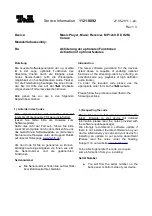
Circuit Operating Descriptions
13-26
Samsung Electronics
2) ACC (Automatic Color Gain Control) Circuit
The ACC is used as burst ACC in the LP mode, however it is also used for peak ACC in the SP/SLP mode.
The purpose of using two different ACC operations is to improve the overall Chroma S/N ratio during playback.
In SP and SLP, there is H-sync alignment. This indicates that there is bust alignment as well. Whenever two video
tracks overlap or a video head picks up crosstalk from an adjacent track, beats are produced during playback.
Perhaps the most noticeable beats are produced by H-sync and burst. But in SP and SLP, these beats occur right at
H-sync and burst and are out of the picture. In LP, however, there is no H-sync alignment and these beats can be
seen in the picture. To keep the beats at a minimum in LP, we keep the burst level constant so that the beat inten-
sity is constant. We know that ACC acts to improve the color S/N,and in LP, the ACC detector locks at the burst
level,and keeps it constant. Thus we have ACC operation with the least beats. In SP and SLP, the beats caused by
burst overlap are out of picture, so we don't really mind if the burst level changes or not. To improve the color
S/N ratio even more,we use peak ACC in SP and SLP.That is,if the chroma level is too low to record, the amplifi-
cation degree is increased by 3dB. However, the chroma level is sufficient for recording, this peak ACC is changed
to burst ACC to avoid over amplification. By changing the ACC according to picture color content, the burst level
may vary. The color ratio improvement is based on the color content itself during SP and SLP provides a some-
what better S/N ratio.
3) Four (4) Phase Rotation
CH1 is advanced 90 degrees every channel, while CH2 is delayed 90 degrees. When the frequency is set to
627KHz, if phase is shifted by +/-90 it becomes /-90. The 40fh+/-90(=/-90)is balanced modu-
lated via fsc (4.43MHz) depending on which side band is detected. That is, the fs +40fh+/-90 (4.2MHz+/-90) of
total frequency is supplied to the main converter. In record mode, the signal operates same as in play back mode.
During playback, the phase is returned to original state.
4) AFC (Automatic Frequency Control) Circuit
Luminance signal is input to H-sync separator. The H-sync is separated and supplied to phase comparator.
This signal can be described as fh (Horizontal Sync frequency of input video signal). However, VCO oscillates at
321fh(5.016MHz). This 321fh is counted down by 1/8 and 1/40 and resultant fh is supplied to phase comparator.
fh and fh are supplied to the phase comparator for comparison of their phases. After comparison, the phase
differences is output to VCO (321fh) in terms of error voltage. Therefore, the oscillation frequency of VCO is
controlled by this error voltage. That is, if the fh phase is changed by H-sync signal fh, error voltage is changed
accordingly and if the phases of fh and fh are met due to change of VCO oscillation frequency, error voltage does
not feedback. 321fh VCO is oscillated in accordance with phase sync at fh. Therefore, 40.125fh input to sub con-
verter by phase shift is always sync horized with phase. The AFC loop performs the same operation during
record and playback. In recording, phase of VCO is in accordance with H-sync signal of current video signal.
Which in playback, the phase sync of VCO is consistent with H-sync signal which is separated from the video
signal.
Summary of Contents for DVD-V5600
Page 14: ...Product Specification 2 4 Samsung Electronics MEMO ...
Page 30: ...3 16 Alignment and Adjustments Samsung Electronics MEMO ...
Page 86: ...Troubleshooting 5 30 Samsung Electronics MEMO ...
Page 98: ...Exploded View and Parts List 6 12 Samsung Electronics MEMO ...
Page 129: ...9 1 9 Wiring Diagram Samsung Electronics ...
Page 130: ...Wiring Diagram 9 2 MEMO Samsung Electronics ...
Page 132: ...PCB Diagrams 10 2 Samsung Electronics 10 1 VCR Main PCB COMPONENT SIDE ...
Page 133: ...PCB Diagrams 10 3 Samsung Electronics A_OUT ˆ ˇ Œ CTL ENV HD SW V_OUT Œ ˇ ˆ ...
Page 134: ...PCB Diagrams 10 4 Samsung Electronics ...
Page 136: ...PCB Diagrams 10 6 Samsung Electronics DIC5 CONDUCTOR SIDE ...
Page 137: ...PCB Diagrams 10 7 Samsung Electronics 10 3 Function PCB CONDUCTOR SIDE COMPONENT SIDE ...
Page 138: ...PCB Diagrams 10 8 Samsung Electronics MEMO ...
Page 157: ...Samsung Electronics 12 1 12 Operating Instructions ...
Page 158: ...Operating Instructions 12 2 Samsung Electronics ...
Page 159: ...Operating Instructions 12 3 Samsung Electronics ...
Page 160: ...Operating Instructions 12 4 Samsung Electronics ...
Page 161: ...Operating Instructions 12 5 Samsung Electronics ...
Page 162: ...Operating Instructions 12 6 Samsung Electronics ...
Page 163: ...Operating Instructions 12 7 Samsung Electronics ...
Page 164: ...Operating Instructions 12 8 Samsung Electronics ...
Page 165: ...Operating Instructions 12 9 Samsung Electronics ...
Page 166: ...Operating Instructions 12 10 Samsung Electronics MEMO ...
Page 173: ...Circuit Operating Descriptions 13 7 Samsung Electronics Fig 13 12 Block Diagram ...
Page 230: ...Reference Information 14 12 Samsung Electronics Fig 14 14 Mecha Timing Chart Kaiser II ...
Page 252: ...Reference Information 14 34 Samsung Electronics MEMO ...
















































